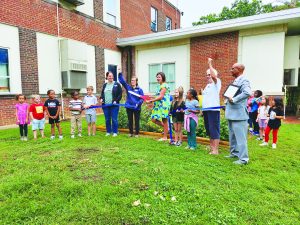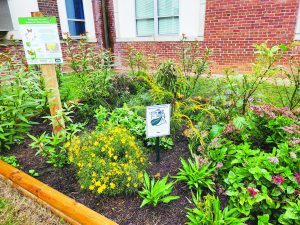A ribbon-cutting ceremony was held at Patrick Henry Elementary School on September 24 to unveil a new monarch waystation, marking the third such installation at schools in the city. The waystation offers students a hands-on learning experience with nature.

“It’s been exciting for students to see how much the plants have grown over the summer since we planted them,” said Principal Cameron Cooper, who confirmed that the project began last spring.
The initiative started when the Dan River Basin Association (DRBA) donated 16 milkweed plants, which students cared for in their classrooms. In addition, Patrick Henry Elementary School (PHES) students raised monarch butterflies and released them outdoors before the end of the school year.
Krista Hodges, DRBA’s education manager, played a key role in connecting with the schools and establishing the waystations. “Our mission is to preserve and promote the natural and cultural resources of the Dan River Basin through education, recreation, and stewardship,” Hodges explained.
The monarch waystations serve as a conservation effort, providing vital rest stops for pollinators. “We work with schools to find suitable locations for planting, and then involve principals, teachers, and students in the process,” said Hodges.
In addition to Patrick Henry Elementary, Martinsville High School and Albert Harris Elementary School have also installed waystations, thanks to assistance from DRBA.

Monarch butterflies face growing threats due to habitat destruction caused by urban development and the use of pesticides and herbicides. “They are on the brink of becoming endangered again, having just reached vulnerable status in 2023,” Hodges noted.
The waystations provide monarchs with a place to rest during their migration to Mexico, as well as nectar sources and breeding grounds. “The milkweed allows monarchs to complete their entire life cycle, as monarch caterpillars can only feed on milkweed plants,” Hodges said.
Students are able to observe this life cycle up close. “They get to get their hands in the dirt, tend the garden, and learn about how plants grow,” said Callie Hietala, community and communications outreach coordinator. “It covers a range of educational topics for different grade levels.”
Hietala added that the waystation supports Standards of Learning (SOL) curriculum, offering students a unique way to study life cycles and plant growth.
“All of these lessons come together to give students a better understanding of how nature works,” said Martinsville Schools Superintendent Dr. Zebedee Talley, who expressed a desire to expand the program, hoping to establish a fourth waystation at Martinsville Middle School and the Clearbrook Early Learning Center. “We’re very excited about this initiative, and we look forward to expanding it.”




